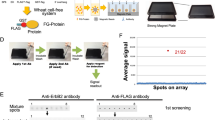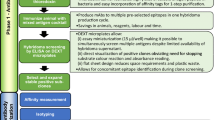Abstract
Despite the wealth of commercially available antibodies to human proteins, research is often hindered by their inconsistent validation, their poor performance and the inadequate coverage of the proteome. These issues could be addressed by systematic, genome-wide efforts to generate and validate renewable protein binders. We report a multicenter study to assess the potential of hybridoma and phage-display technologies in a coordinated large-scale antibody generation and validation effort. We produced over 1,000 antibodies targeting 20 SH2 domain proteins and evaluated them for potency and specificity by enzyme-linked immunosorbent assay (ELISA), protein microarray and surface plasmon resonance (SPR). We also tested selected antibodies in immunoprecipitation, immunoblotting and immunofluorescence assays. Our results show that high-affinity, high-specificity renewable antibodies generated by different technologies can be produced quickly and efficiently. We believe that this work serves as a foundation and template for future larger-scale studies to create renewable protein binders.
This is a preview of subscription content, access via your institution
Access options
Subscribe to this journal
Receive 12 print issues and online access
$259.00 per year
only $21.58 per issue
Buy this article
- Purchase on Springer Link
- Instant access to full article PDF
Prices may be subject to local taxes which are calculated during checkout




Similar content being viewed by others
References
Taussig, M.J. et al. ProteomeBinders: planning a European resource of affinity reagents for analysis of the human proteome. Nat. Methods 4, 13–17 (2007).
Bordeaux, J. et al. Antibody validation. Biotechniques 48, 197–209 (2010).
Uhlén, M. et al. A human protein atlas for normal and cancer tissues based on antibody proteomics. Mol. Cell. Proteomics 4, 1920–1932 (2005).
Berglund, L. et al. A genecentric Human Protein Atlas for expression profiles based on antibodies. Mol. Cell. Proteomics 7, 2019–2027 (2008).
Nilsson, P. et al. Towards a human proteome atlas: high-throughput generation of mono-specific antibodies for tissue profiling. Proteomics 5, 4327–4337 (2005).
Ohara, R. et al. Antibodies for proteomic research: comparison of traditional immunization with recombinant antibody technology. Proteomics 6, 2638–2646 (2006).
Schofield, D.J. et al. Application of phage display to high throughput antibody generation and characterization. Genome Biol. 8, R254 (2007).
De Masi, F. et al. High throughput production of mouse monoclonal antibodies using antigen microarrays. Proteomics 5, 4070–4081 (2005).
Hust, M. & Dübel, S. Mating antibody phage display with proteomics. Trends Biotechnol. 22, 8–14 (2004).
Konthur, Z., Hust, M. & Dübel, S. Perspectives for systematic in vitro antibody generation. Gene 364, 19–29 (2005).
Dübel, S., Stoevesand, O., Taussig, M.J. & Hust, M. Generating recombinant antibodies to the complete human proteome. Trends Biotechnol. 28, 333–339 (2010).
Blow, N. Antibodies: the generation game. Nature 447, 741–744 (2007).
Uhlén, M., Gräslund, S. & Sundstrom, M. A pilot project to generate affinity reagents to human proteins. Nat. Methods 5, 854–855 (2008).
Scott, J.D. & Pawson, T. Cell signaling in space and time: where proteins come together and when they′re apart. Science 326, 1220–1224 (2009).
Seet, B.T., Dikic, I., Zhou, M.M. & Pawson, T. Reading protein modifications with interaction domains. Nat. Rev. Mol. Cell Biol. 7, 473–483 (2006).
Mersmann, M. et al. Towards proteome scale antibody selections using phage display. New Biotechnol. 27, 118–128 (2010).
Pershad, K. et al. Generating a panel of highly specific antibodies to 20 human SH2 domains by phage display. Protein Eng. Des. Sel. 23, 279–288 (2010).
Hust, M. et al. A human scFv antibody generation pipeline for proteome research. J. Biotechnol. 152, 159–170 (2010).
Nice, E.C. & Catimel, B. Instrumental biosensors: new perspectives for the analysis of biomolecular interactions. Bioessays 21, 339–352 (1999).
Thie, H., Binius, S., Schirrmann, T., Hust, M. & Dübel, S. Multimerization domains for antibody phage display and antibody production. New Biotechnol. 26, 314–321 (2009).
Martin, C.D. et al. A simple vector system to improve performance and utilisation of recombinant antibodies. BMC Biotechnol. 6, 46 (2006).
Dufner, P., Jermutus, L. & Minter, R.R. Harnessing phage and ribosome display for antibody optimisation. Trends Biotechnol. 24, 523–529 (2006).
Moutel, S. et al. A multi-Fc-species system for recombinant antibody production. BMC Biotechnol. 9, 14 (2009).
Schütte, M. et al. Identification of a putative Crf splice variant and generation of recombinant antibodies for the specific detection of Aspergillus fumigatus. PLoS ONE 4, e6625 (2009).
Luzi, L., Confalonieri, S., Di Fiore, P.P. & Pelicci, P.G. Evolution of Shc functions from nematode to human. Curr. Opin. Genet. Dev. 10, 668–674 (2000).
Sorkin, A. Internalization of the epidermal growth factor receptor: role in signalling. Biochem. Soc. Trans. 29, 480–484 (2001).
Hollinshead, M., Sanderson, J. & Vaux, D.J. Anti-biotin antibodies offer superior organelle-specific labeling of mitochondria over avidin or streptavidin. J. Histochem. Cytochem. 45, 1053–1057 (1997).
Bradbury, A.R., Sidhu, S., Dübel, S. & McCafferty, J. Beyond natural antibodies: the power of in vitro display technologies. Nat. Biotechnol. 29, 245–254 (2011).
Li, B. et al. Activation of the proapoptotic death receptor DR5 by oligomeric peptide and antibody agonists. J. Mol. Biol. 361, 522–536 (2006).
Thie, H. et al. Rise and fall of an anti-MUC1 specific antibody. PLoS ONE 6, e15921 (2011).
Liu, B.A. et al. The human and mouse complement of SH2 domain proteins-establishing the boundaries of phosphotyrosine signaling. Mol. Cell 22, 851–868 (2006).
Linding, R., Russell, R.B., Neduva, V. & Gibson, T.J. GlobPlot: Exploring protein sequences for globularity and disorder. Nucleic Acids Res. 31, 3701–3708 (2003).
Colwill, K. et al. Modification of the Creator recombination system for proteomics applications–improved expression by addition of splice sites. BMC Biotechnol. 6, 13 (2006).
Sundqvist, G., Stenvall, M., Berglund, H., Ottosson, J. & Brumer, H. A general, robust method for the quality control of intact proteins using LC-ESI-MS. J. Chromatogr. B Analyt. Technol. Biomed. Life Sci. 852, 188–194 (2007).
Fellouse, F.A. et al. High-throughput generation of synthetic antibodies from highly functional minimalist phage-displayed libraries. J. Mol. Biol. 373, 924–940 (2007).
Sidhu, S.S. et al. Phage-displayed antibody libraries of synthetic heavy chain complementarity determining regions. J. Mol. Biol. 338, 299–310 (2004).
Hust, M. et al. Improved microtitre plate production of single chain Fv fragments in Escherichia coli. New Biotechnol. 25, 424–428 (2009).
Deshayes, K. et al. Rapid identification of small binding motifs with high-throughput phage display: discovery of peptidic antagonists of IGF-1 function. Chem. Biol. 9, 495–505 (2002).
Evan, G.I., Lewis, G.K., Ramsay, G. & Bishop, J.M. Isolation of monoclonal antibodies specific for human c-myc proto-oncogene product. Mol. Cell. Biol. 5, 3610–3616 (1985).
Acknowledgements
We acknowledge B. Liu and P. Nash for providing SH2 domain alignments; N. Bisson (Samuel Lunenfeld Research Institute) for providing a stable cell line encoding Flag-tagged Grb2; M. Taussig and M. Sundstrom for helpful discussions; and N. Bisson and B. Liu for critically reading the manuscript. The Structural Genomics Consortium is a registered charity (number 1097737) that receives funds from the Canadian Institutes for Health Research, the Canadian Foundation for Innovation, Genome Canada through the Ontario Genomics Institute, GlaxoSmithKline, Karolinska Institutet, the Knut and Alice Wallenberg Foundation, the Ontario Innovation Trust, the Ontario Ministry for Research and Innovation, Merck & Co., Inc., the Novartis Research Foundation, the Swedish Agency for Innovation Systems, the Swedish Foundation for Strategic Research and the Wellcome Trust. This work was also supported by funds from Genome Canada through the Ontario Genomics Institute and Ontario Research Fund Global Leadership Round in Genomics and Life Sciences (to T.P.), The Human Frontier Science Program (O.R.), the European Commission 6th framework program coordination action 'Proteome Binders' (S.D.), from the Systematisch-Methodischen Platform Antibody Factory, within the German Nationales Genomforschungsnetz (S.D.), the Land Niedersachsen (S.D.), the Wellcome Trust (J.Mc.), the US National Institutes of Health (GM082288-09A1 and EY016094-01A1 to B.K.K. and R01-GM72688 and U54-GM74946 to A.A.K. and S.K.), to the Swedish Research Council (524-2008-617) (H.P.), and the Victorian State Government (The Department of Innovation, Industry and Regional Development), the Australian Federal Government (Bioplatforms Australia) and Monash University for financial support for the Monash Antibody Technologies Facility.
Author information
Authors and Affiliations
Consortia
Contributions
K.P., J.D.P., A.K.-V., D.J.S., N.E.J., A.W., J.Wo., A.K., M.M., D.M., J.M., S.H., S.B., A.F., M.S., K.W., A.D., K.H., M.S., R.S., J.M.S., A.S., J.O., S.H., L.-G.D., A.F., I.J., L.C., P.L., I.K., D.L. and F.A.F. designed and performed experiments; M.R.D., M.H., H.P., O.R., P.N., E.N. and D.C. conceived, designed and performed experiments and wrote the paper; J.We., C.H.A., B.K.K., A.A.K. and M.U. oversaw the project; J.Mc., S.K., S.S., S.D., A.S., T.P. and A.M.E. conceived and oversaw the project and wrote the paper; K.C. and S.G. conceived, designed and performed experiments, oversaw the project and wrote the paper.
Corresponding authors
Ethics declarations
Competing interests
The authors declare no competing financial interests.
Additional information
A full list of authors appears at the end of this paper.
Supplementary information
Supplementary Text and Figures
Supplementary Figures 1–5 and Supplementary Table 2 (PDF 997 kb)
Supplementary Table 1
Summary of the results at each step in this study. (XLS 70 kb)
Supplementary Table 3
Construction and sequence of SH2 domains. (XLS 159 kb)
Rights and permissions
About this article
Cite this article
Colwill, K., Renewable Protein Binder Working Group. & Gräslund, S. A roadmap to generate renewable protein binders to the human proteome. Nat Methods 8, 551–558 (2011). https://doi.org/10.1038/nmeth.1607
Received:
Accepted:
Published:
Issue Date:
DOI: https://doi.org/10.1038/nmeth.1607
This article is cited by
-
Network pharmacology and experimental verification study on the mechanism of Hedyotis diffusa Willd in treating colorectal cancer
Naunyn-Schmiedeberg's Archives of Pharmacology (2024)
-
Characterizing excision repair cross-complementing family genes as drug resistance biomarkers in breast cancer
Beni-Suef University Journal of Basic and Applied Sciences (2023)
-
Multidimensional analysis to elucidate the possible mechanism of bone metastasis in breast cancer
BMC Cancer (2023)
-
Comprehensive analysis of the potential biological significance of cuproptosis-related gene LIPT2 in pan-cancer prognosis and immunotherapy
Scientific Reports (2023)
-
Pan-cancer analysis revealing that PTPN2 is an indicator of risk stratification for acute myeloid leukemia
Scientific Reports (2023)



